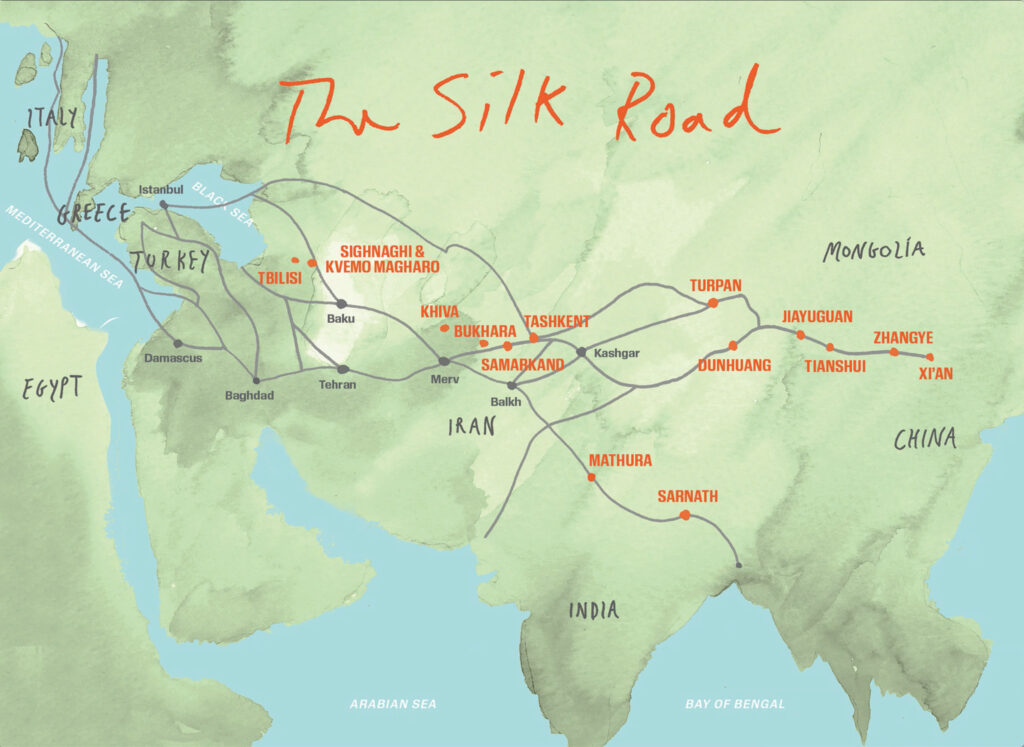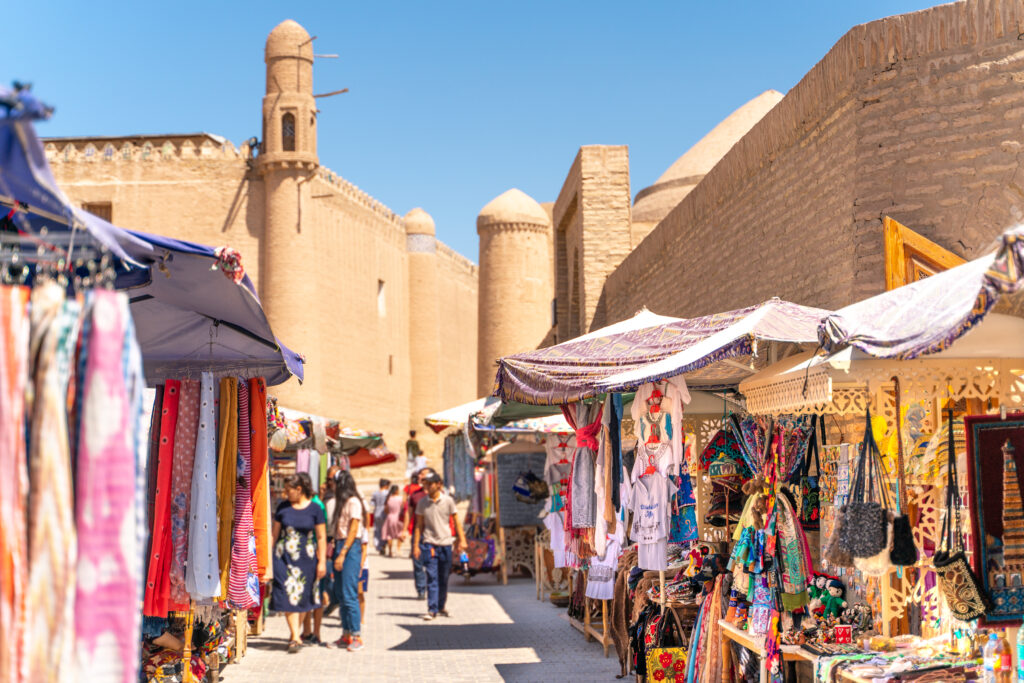The Silk Road – a route of learning and cultural interplay
by Mihaela Manolache
One of the oldest trading routes in the world, the Silk Road is a symbol of an unstopped revolve of ideas, cultures, stories, and goods. The route spanning from Europe to China sparked the imagination of traders who were eager both to discover the world and obtain financial satisfaction. Wool, horses, honey, gold, and silver went eastward meanwhile teas, perfumes, dyes, spices, and silk went westward through several routes. In fact, the silk routes are a vast network of maritime and land directions passing from China and India to Central Asia and its northern steppes to the Iranian and Anatolian plateaus. From here, the route crosses the Mediterranean Sea reaching South Europe to Italy, France, and Spain.
GET MORE FROM LEVEL

The prolific cultural and economic exchange between the West and the East was active between the 2nd century BC and until the mid-15th century. The 6.400 km long route explored many cultural traditions and facilitated economic, political, and religious interactions between two opposite parts of the world. Today the ancient route goes across many countries and lights a fire in the hearts of travellers that are eager to experience a two thousand years old route of culture and world heritage.
However, the networks of the Silk Roads meant more than just trading as the populations involved along the route were in constant dialogue, evolution, and interplay. The process allowed a wide transmission of ideas and beliefs influencing at a profound level both the Western and Eurasian peoples. Traders were people of creativity and business instinct who also showed great interest in intellectual knowledge and progress. Cities along the route were true hubs of learning where science, arts, and technologies were available and disseminated into societies, managing to create a vivid dialogue and link between the Roman Empire and Chinese provinces.
Why the” Silk Road”
Ancient Chinese cultivated silkworms for the protein fiber produced in the process of making their cocoons. From the fiber, manufacturers weaved a highly valuable product – silk. According to Chinese tradition, sericulture was developed in the third millennium BC for the exclusive use of the Chinese imperial court. Cloths, tapestries, banners, and other luxury items were made for the elite as a token of their power. The process of making silk was kept secret for more than 3.000 years, the imperial court issuing decrees with the death penalty for everyone who would reveal anything from the know-how of the skill.
As the Chinese army established itself in Central Asia, the Chinese elite began to spread its influence and trade silk for other precious commodities. The Han dynasty began its expansion toward the Asian steppes around 114 BC. First, the imperial emissary explored unknown areas with the clear purpose of finding potential trading partners. Following a positive response to the expeditions, the Chinese empire configured diplomatic and commercial dispatches into several regions of Central Asia. In addition to this, the empire made great efforts to protect its new routes and extended the Great Wall.
Around the 1st century BC, the Roman Empire got into contact with silk and this became an exotic luxury item owned, once again, only by the nobles. By the 1st century AC, Chinese silk was highly sought throughout the Roman Empire, Egypt, and Greek islands. Apart from the mercantile success, the popularity and influence of some items such as paper or gunpowder, replaced parchment, improved the standards of life, and changed the military history of the world.
During the Byzantine period, silk was mainly used for the manufacture of royal clothes and silk garments. The substantial need of the Byzantine Church for silk helped to develop the trading routes from Europe to China. Together with the technological advances in the science of navigation, astronomy, and ship-building techniques, new long-distance sea routes appeared, through the Arabian Peninsula. Vivid cities along the coast turned into effervescent ports. Only to name a few – Alexandria, Muscat, and Goa in India, which were not only important commercial centers with large markets but also hubs for the exchange of languages, ideas, and technologies, hosting many immigrants, foreigners, sailors, and travellers.

Although the name ”Silk Road” was officially accepted only in the 19th century, it seems scholars agree that the Silk Routes is more accurate in terms of describing the spider web network of both land and sea circuits. The paths created a link between Asia, the Middle East, Africa, and Europe.
Marco Polo’s Journey Along the Silk Route
The Silk Road was traveled entirely only by a few people, true adventurers. Normally, the route was split into portions, and regional middlemen organised and led the caravans through the inhospitable landscape. Due to its decentralised structure, travellers had to face thefts, banditry raiders, and constant insecurity. In the late Middle Ages, Ottoman Empire’s development in the Anatolian region hindered trading on the route, culminating with its disruption in 1453 due to the conquest of Istanbul by Mehmed II. Europe urged to seek alternative ways to the East, thereby opening the way for the Age of Discovery and European colonialism.
Marco Polo is a worldwide famous historical trader who lived in Venice in the 13th century. As a passionate merchant and traveler, he was among the first Europeans to visit and describe connections with the East. He traveled the Silk Road between 1271 and 1295 and recorded his stories in ”The Travels of Marco Polo”. The book narrated the eastern cultures in a comprehensible way, describing the geography, ethnic customs, paper money, exotic plants, and animals, as well as providing an overall view of the wealth and the size of the Mongol Empire and Yuan Dynasty in China. It is considered the first extensive understanding of the Chinese, Persian, Indian, and other Asian cultures. His writings inspired generations of sailors and travellers, including Christopher Columbus.
Dialogue at all Levels
Merchants became wealthy by trading local products in Eurasian ports and cities but together with commercial exchange other beliefs spread. Buddhism with its art and shrines traveled along the route and spread as a religion due to the existence of the Silk Road. Travellers adopted customs and religions along the route and took them back home or were accompanied by monks who preached the new religion. One can find examples of Buddhism as far as Afghanistan and Indonesia. Other religions spread the same way such as Christianity, Islam, Hinduism, and Manicheism. The Silk Road was the main path for development in terms of Catholic faith dissemination, mainly during the Middle Ages.
Central Asia developed intensely due to the Silk Road across its territory. The constructions from the 10th century onwards are relevant as caravanserais became a necessity. The development stopped somewhere in the 19th century but the network of stopping points and caravanserais still exists today across the Asian continent.
China’s influence in terms of sericulture and paper making was critical for Central Asia, where several points opened adopting these activities for their gains. Chinese handicrafts were present in Samarkand in the 8th century, developing prolific centers of manufacturing. While traveling toward the West, paper replaced former writing materials such as parchment and papyrus.

International dialogue is visible at the architectural level and in town planning. Monuments proof of this exchange are Timur’s structures in Samarkand, mosques in the region of Turkestan, the Timurids tombs at Gur-Emir, and Ak-Serai palace in Shahrisabz, Uzbekistan. The monuments present combined architectural features and styles, as well as building techniques from several cultures. Similarly, many monuments were erected by Central Asia architects, and building masters from Iran, Armenia, Iraq, and India.
The art of glass-making traveled toward China, becoming a central preoccupation for the Asian people. Music, dances, and theatre performances traveled both ways, influencing one another. It is a very popular fact that at Constantinople Asian actors often performed for the Roman emperors.
The legacy of the Silk Road is inestimable for the cultural gains, learning process, inventions, and technologies dispersed along the way. Today many historic symbols and monuments still stand and mark in a precise manner the passage of the ancient trading route along Eurasia. Caravanserais, ports, and cities together with their remarkable structure reflect the cultural interplay and continuous interaction that developed over millennia resulting in fascinating fairy tale stories that today draw tourists from all corners of the world.
The Silk Road Through the Eyes of Youth
Heritage is composed of both tangible and intangible culture. We learn about the past and we transmit it to future generations, thousands of years of human evolution. Young generations today are interested more than ever in the history of countries of the world, nationalities, and the unique experience of travel interaction. Globalization is a phenomenon that allows everyone to access information everywhere. Technology and transportation progress allows us to reach other continents within hours. In the Western world, young people wish to discover and experience other cultures so traveling, studying abroad, and working for international companies is a rising trend. A broad range of education programs, internships, and travel cards are available for individuals up to 30 years old.

Some travel by foot, others by bike or campers. People travel to experience, live authentically, and enrich the spirit by broadening their horizons, opening up their souls, and accepting differences. Scholars agree that the younger generations are more flexible and tolerant with respect to their parents or grandparents. Kindness must be a main feature of young people to become thoughtful and well-balanced adults.
For many, the Silk Road and its mesmerising caravanserais is a cultural pilgrimage where people can experience diversity in a nutshell. A culinary delight, new human physiognomies, colourful traditional costumes, lavish garments, unique landscapes, and millennia-old heritage are elements not only to learn about the past but also to discover ourselves and our history. We find out that physical limits are not important but deep inside we are all made of the same dough: flesh, bones, and emotions.



Leave a Reply